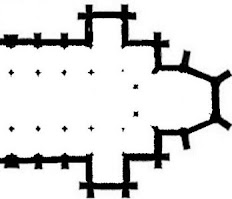In 1854, a foundation for the second cathedral was found under the choir and presbytery floor. Its size and shape were drawn by John Hamlet, who had been commissioned to build brick ducts under the floor to carry hot air. The foundation was basilical in form with an east end in the shape of a semi-circular apse. By every measurement it was extraordinary.[1]
 |
| Hamlet’s 1854 drawing of the foundation together with the published drawing by Willis, 1861. [2] |
 |
| A comparison of apse sizes of early churches. |
A review of other Norman and Anglo-Norman cathedrals that
have had a round apse emphasises the incomparable shape of this foundation. The
following diagrams are not to scale and dates are approximations, but show
large churches with a distinct, round apse.
Conjectured east end of Canterbury 1030.
The apse has a north and south porticus. It was only 9.2 m across at the chord.
The whole of the east end was changed in 1095 by extension with towers and a
chapel.
Ely 1083, but whether it had an apse is
uncertain, it was soon squared off.
Peterborough 1118.The hemispherical apse was
built on polygonal columns, later retained and enclosed in a squared end, 1500.
Old Sarum, Salisbury, late 12th-century.
Westminster Abbey 1245–69. A Lady Chapel
was added to give 5 apsidal chapels.
Bury St Edmunds Abbey 12th-century.
Wells 1175, squared in the 14th-century with a
polygonal chapel.
Norman cathedrals only having square-ended chancels
are St Albans, Chichester, Hereford[4], Lincoln (?), Old St
Pauls, Rochester, Southwell, Winchester (?) and York. Durham had an apse for
Cuthbert’s shrine, but then the east end was squared off; the line of the apse
can be seen in the pavement. Exeter had a five-sided apse c. 1133, but
by 1292–1308, the current squared east end was built containing several side
chapels.
It is clear Canterbury, late-10th or early 11th-century, comes closest to being like Lichfield, if its floor plan is true, but the conclusion can only be the Lichfield apse has no obvious equivalent.
When
Rodwell investigated the foundation in the south and then the north choir aisle[5] he made a comparison with
Norwich Cathedral and conjectured the existence of apsidioles off the apse, but
then failed to find any. Instead, he suggested the absence of chapels or
apsidioles off an eastern apse was comparable to early and small Jumiège Abbey,
begun 1037 and consecrated 1067. However, the simple round apse with an
ambulatory at Jumièges was a conjectured layout after a 1935 excavation and is
part of a church floor plan which has yet to be fully understood and agreed.
The dimensions of its putative apse, c. 70 x 70 feet, was close to the
Lichfield apse. Similarly, the apse could have a resemblance to the slightly
earlier apse at Bernay Abbey,
East end of St Pierre, Jumiège Abbey, showing
reconstructed floor plan for 1037–67. Soon after, c. 1040, it had a series of
small apsidioles.
Bernay Abbey 1010–55, the oldest surviving Norman
Romanesque church with a simple round apse. It might be how the east ends were
truly built in early Norman times.
A search of all Romanesque churches, 800–1200, as described
by Krautheimer[6]
and Conant[7] has failed to find a close
affinity with the apse at Lichfield with the early build of Jumièges Abbey
coming closest. A good resemblance is St Denis Abbey, located in a suburb of
northern Paris[8].
Abbot Fulrad built a basilica church, dedicated c.775, with many
features modelled on St Peters in Rome. Partial excavation in 1938 by Crosby[9] revealed a wooden roofed
columnar basilica with a spacious adjunct extending a little beyond the aisle
walls, a lantern tower, a new kind of west end, and a simple, short, apse
extending from the east end.
Reconstructed
Basilica of Saint-Denis, the earliest Carolingian Romanesque church. Nave and
apse were 30 feet wide. The alignment of the crypt is unexplained and shape
conjectured.
Conclusions
- A simple, very wide, hemispherical apse is extraordinary and there
is no good homology with any of the British Norman churches.
- Comparable churches are either very early Norman (early conjectured
Canterbury, Jumiège and Bernay) or early Romanesque churches such as the
abbey of St Denis.
- Dating this foundation has been extremely contentious. A current
cathedral pamphlet states it was built around 1085 and is Norman. This has
been given without any evidence, apart from the opinion of a visiting
academic who seemed to know it was Norman before he led any archaeological
excavation. Other later dates have also been given without any supporting
evidence. Why the cathedral allows such unsubstantiated dating to be
contained in its history is inexplicable. It discredits the historical
narrative.
- The dimensions of the foundation have an Anglo-Saxon metric of a
short perch (15 feet) and not a Norman rule of a long perch (18 feet). See
note 1.
- The mortar of the foundation
needs to be carbon-dated. It would be a relatively simple and cheap
project. Four top historians have called for this work to be done. Others
have expressed surprise it is not a priority. Guides are conflicted by the
omission.
[1] More detail is given in
the post, ‘It is short perch: historians, please note.’
[2] R. Willis, ‘On foundations of early buildings recently discovered
in Lichfield Cathedral.’ The Archaeological Journal, (1861), 18, 1--24.
[3] There is a problem with naming
the people Saxon or Anglo-Saxon (the preferred title in academic publications).
Based on surviving texts, early inhabitants of the region were commonly called englisc and angelcynn.
From 410 A.D. when the Romans left to shortly after 1066, the Anglo-Saxon term
only appears three times in legal charters in the entire corpus of Old
English literature and all are in the tenth century. It is used here because
Anglo-Saxon is understood despite being inaccurate.
[4] At
Hereford, there were three supposed apses in 1079 which changed between 1226
and 1246 to square chapels, but it is very uncertain.
[5] W. Rodwell, W. Revealing
the history of the Cathedral., Cathedral report in the Cathedral
Library. (1992). 24–34;
W. Rodwell, An interim report on archaeological excavations in the south
quire aisle of Lichfield Cathedral. Lichfield Cathedral report
in the Cathedral Library (1992) 1—8 and W. Rodwell, Revealing the
history of the Cathedral. Lichfield Cathedral report in the Cathedral
Library, (1994), 20–31.
[6] R. Krautheimer, R. Early
Christian and Byzantine architecture. (Harmondsworth: 1965).
[7] K. J. Conant, Carolingian and Romanesque
architecture, 800–1200. (New Haven and London: 1978).
[8] The old church, c. 475,
resembled Wilfrid’s church at Hexham according to Clapham (Oxford: 1930).
[9] S. M. Crosby, The Royal
Abbey of Saint-Denis from its beginnings to the death of Suger, 475–1151. (New
Haven and London: 1987).












